|
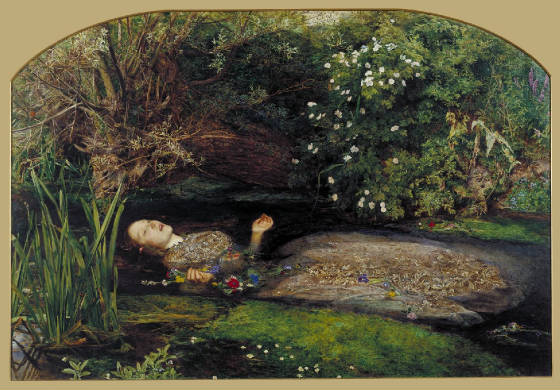
John Everett Millais, Ophelia (1851-2). By Permission of the Tate Britain, London.
Pre-Raphaelites:
Victorian Avant-Garde at Tate Britain, London
By Anna Leung
“to see clearly is poetry,
prophesy and religion all in one’” Ruskin‘True
work is Worship.’ Carlyle
Despite the passing of the years, which generally makes
even the most recalcitrant of art movements more or less acceptable, the Pre-Raphaelites remain strangely compelling. Given
the unrelenting details of their picture making this is not surprising, demanding as it does of the viewer a protracted interrogation
of each canvas. This we are no longer used to doing. However their fixation on honest labour, resulting in hours spent confronting
a particular landscape in all weathers, is itself Victorian as are the moral earnestness, the emphasis on contemporary social
and religious issues, and the demand for quasi scientific observation which characterised the early phase of the movement.
The second phase, inaugurated by William Morris and Burne-Jones with Rossetti as principle mentor, turned this focus away
from its initial reference to the natural world towards an internal world, a tendency that reaches its apogee with William
Morris’s attempt to transform society through design and Burne-Jones’s dreamscapes. Moral earnestness is not commonly
associated with the avant-garde. But in both phases of the movement aimed to give art a social function, a use that could
be understood not only by the literati but by the general public as well.
Initially this was
to be achieved by investing art with a new seriousness and attempting to communicate to a wider audience through a new pictorial
language divested of all the stylised cobwebs and the mere prettiness of academic art as fostered by their pet hate figure
Joshua Reynolds, a.k.a. Sir Sloshua (slosh standing for bad art). Fired in their first meetings by the engravings of frescoes
by Gozzoli the brotherhood resolved that the way forward was to emulate the clarity of the pre-renaissance Italian artists
whose paintings up till that time were dismissed as crude and immature. Henceforth this ‘archaic’ or ‘primitivist’
stratagem was to become a foremost trope for ambitious contenders for avant-garde status giving rise to Fauvism and Cubism
in France and to Die Brücke in Germany. Each group sought a return to first principles that flouted academic conventions in
order to create not only a new language of painting but, in the latter case, a whole new way of living. For the Brotherhood
art and politics were intimately intertwined, in some instances featuring a magnetic positive in others a magnetic negative
with regard to social issues. Rossetti was the pivotal figure in both phases, so much so that despite his virtual disengagement
from social issues and his lack of technical skills it is more often than not his images of eroticised women that erroneously
occupy the public imagination when it comes to defining the Pre-Raphaelite Movement.
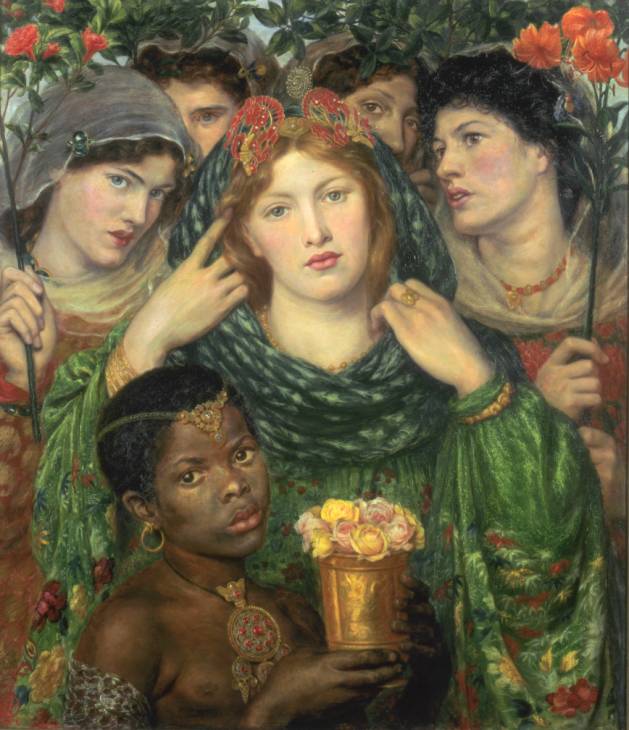
Dante Gabriel Rossetti, The Beloved (The Bride) (1865-6). Permission of Tate Britain.
The leading members
of the movement were John Everett Millais, Dante Gabriel Rossetti and William Holman Hunt. All students at the Royal Academy
School, they convened as a secret brotherhood in September 1848, a year of intense revolutionary fervour across Europe. Revolutionary
activism in England was restricted to the Chartist movement, whose huge demonstration petitioning parliament for the vote
was witnessed by Hunt and Millais, but significantly from a safe distance. The monastic model was inspired by the German Brotherhood
of Saint Luke, a group of artists who were known as the Nazarenes and were the first artists to draw attention to Italian
and Nordic artists who predated the renaissance (Giotto, Cimabue, Memling and Van Eyck). That the PRB actually had much contact
with such painting, except in the form of secondary reproductions, is in doubt but their aim was not to imitate the look of
pre-renaissance art but to initiate a shift in attitudes based on the earlier artists’ attention to everyday details,
for this was to be a new form of realism ‘obtained’ according to Ruskin ‘in working everything down to the
most minute detail from nature, and from nature only.’ Consequently what differentiated
this from other forms of realism, consider Courbet, was precisely its insistence on the minutest attention given not only
to natural but also to common day contemporary details. This revealed a Protestant sensibility that brought together a social
conscience and a search for spiritual truth while significantly not rejecting the past as the French were to do. Historical
events were used to cast light on contemporary social issues. Thus the first phase of Pre-Raphaelitism tended to concentrate
on historical and biblical narratives that portrayed protagonists in as historically accurate costumes and contexts as possible.
But what made this orientation specifically Protestant was its egalitarian dimension in terms of technique. By dispensing
with Reynolds’s hierarchical composition and the academy’s emphasis on abstract generalities in favour of a truth
that included all particulars Pre-Raphaelitism implicitly dispensed with the notion of the self and the cult of the romantic
genius thereby reducing to a minimum the subjectivity of the observer. Consequently, they privileged detail over the overall
design. The way the whole canvas was made up of a multitude of individual observations created a flattening effect, which
meant that landscape, for instance, had no middle ground since the background was as distinct as the foreground. The artist
was transformed into a human eye recording reality much like the lens of the camera--it was during this period that the daguerreotype
and the calotype were producing a new vision. It is important to recognise, however, that the PRB were not trying to imitate
the photographic image, which, unlike their own hard- edged hyperrealism modelled on pre-renaissance images, displayed areas
of soft focus and of course could not compete in terms of colour. Moreover, photography was still taking painting as its model
– see Julia Margaret Cameron in relation to the Aesthetic Movement.
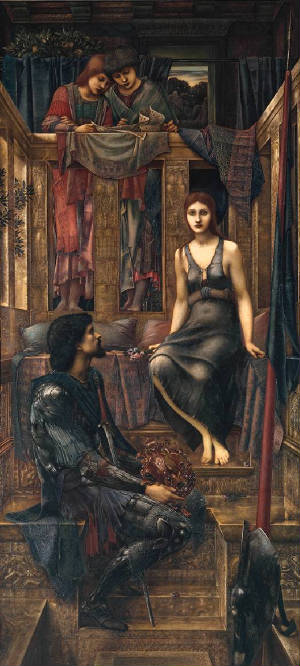
|
| Edward Burne-Jones, King Cophetua and the Beggar Maid (1884). Permission Tate Britain. |
Colour undoubtedly plays a major role in the
movement, its importance pertaining not only to aesthetic, but to political matters. Colour stood for all that was denied
by the utilitarian society that tended to view it as a superficial quality. It was also associated with the uneducated taste
of children and primitive or uncultured peoples. The use of bright colours at a time when new chemical pigments, such as a
range of purples (Arthur Hughes’s signature colour), chromium and cobalt yellows and emerald green were being introduced
to the market in portable tubes may well have struck first time viewers as painfully strident and even transgressive. Millais’s
The Blind Girl, for instance, was described as painted with ‘sweetmeat rainbows of lollypop colours.’ The
adoption of a white ground and the building up of a paint surface through countless small brushstrokes, painting wet into
wet, all intensified the translucent effects of colour, making it seem vulgar to their contemporaries. Fellow artists were
not exempt. Ford Maddox Brown complained of a green ‘unripe enough to cause indigestion’ in one of Millais’s
landscapes. His own use of rose madder for the ribbon in Last of England might have received a similar reproof. For it remained
separate and no effort was made to subordinate it to the overall composition; in fact, quite the reverse.
Central
to an understanding of the early or first phase of the Pre-R is this conviction that painting is able to present a truthful
vision. This belief was based on Ruskin’s notion of the innocence of the eye unmediated by the conventions of seeing.
Painting then was credited with a revelatory and in some cases a corrective power that it was the artist’s duty to communicate
to the public. Thus scientific observation was complimented by a trenchant belief in the social function of art. The Pre-R’s
paradoxical extolling of the anonymity of the mediaeval artist/artisan makes perfect sense when viewed in this context. Defending
the mediaeval artisan was a way of speaking up for the dignity of labour and the common man while at the same time denouncing
ossified academic conventions. The idealisation of the mediaeval period championed by Pugin and Ruskin at a time when Carlyle
too had fulminated against what he called ‘the Mechanical Age and its instrumental values’ was an indirect way
of withstanding the assault of modernity and defending art from marginalisation in Victorian society on one hand and asserting
its independence from instrumental values, where everything was subject to commodification, on the other. Art took on the
role of the great resister with the artist adopting an ethical stance as a conduit of truth - a very avant-garde position.
Ironically when the Pre-Raphaelites began to sell their work it was to the captains of industry that they sold them. Perhaps
they more than any other segment of society recognised that they needed a form of escapism which itself was fast becoming
absorbed by the capitalist cash nexus.
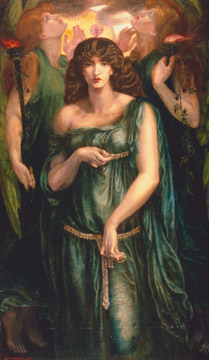
|
| Dante Gabriel Rosetti, Astarte Syriaca (1877). Manchester City Galleries. |
But initially escapism was far from the brotherhood’s minds. Ruskin’s ideas were translated into a
quest to create a visual language able to register the most pressing issues of contemporary society through a literalist account
of physical reality. This examination of the impact of modernity on social life constitutes the subject matter of Holman Hunt’s
The Awakening Conscience with its kitsch setting of a fallen woman and its pendant The Light of the World; Millais’s
Isabella, which indirectly alludes to the class struggle and his demystifying Christ in the House of his Parents;
Ford Maddox Brown’s epic Work, an allegory about the organisation of labour that juxtaposes the different kinds
of labour including that of the mind in the figure of Carlyle to the right; and The Last of England which illustrates
how poverty was forcing families to emigrate and English Autumn Afternoon, 1852-3. Even Rossetti attempted to take
on the contemporary problem of prostitution in his unfinished Found. Most pictures were met with a mixture of praise
and blame but Millais’s Christ in the House of his Parents, 1849-50, inspired as abusive criticism as any avant-garde
art work. It was described in pathological terms, regarded as bordering on the blasphemous, its style scorned as grotesque
and caricatural and taken as a representative of a new revolutionary movement that imperilled Britain’s cultural heritage.
Dickens penned the most vicious assault on the painting describing Millais’s depiction of Christ as ‘a hideous,
wry-necked, blubbering red-headed boy disguised in a bed gown’ and Mary as ‘a monster in the vilest cabaret in
France, or in the lowest gin shop in England.’ Contrast this abusive response with Millais’s and Hunt’s
reception in the Paris salon of 1855 where they were feted for their originality in terms of subject matter and method.
There was, however, some substance to this criticism
for one of the main tenets of the new aesthetic was an emphasis on expression and character at the expense of beauty and on
capturing a vernacular of gesture to represent transitory emotions. If we contrast Millais’s depiction of the Holy Family
with Herbert’s in his painting The Youth of Our Lord the difference is obvious. The figures in the latter have
little in common with Millais’s, whose Saint Joseph is not idealised but has the distinct physiognomy of a particular
individual – in all likelihood one of the group or one of their friends – while Mary has a distinctively Flemish
look. In addition Millais, rather than using traditional signifiers such as haloes, makes use of typological signifiers, everyday
objects invested with an added symbolic meaning, e.g. the three nails and the pliers on the work surface that prefigure Christ’s
death on the cross, the dove on the ladder, and the sheep staring rather fixedly in from outside the carpenter’s workshop.
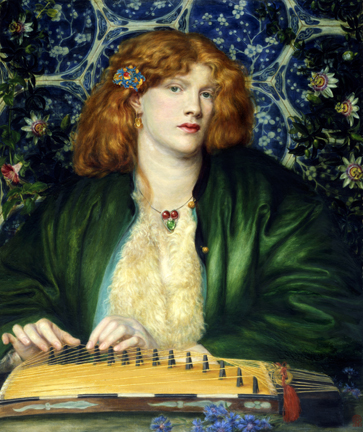
Dante Gabriel Rosetti, The Blue Bower (1865). The Trustees of the Barber Institute of Fine
Arts, University of Birmingham.
Religious themes presented the movement with
some of their main artistic challenges forcing them to engage with the problem of relating the seen and the unseen, the empirical
and the spiritual and the supernatural and the natural. Over and above this was the difficulty of giving such matters a convincing
visual representation in an age that was both imbued with a positivistic spirit demanding empirical evidence and increasingly
beset by doubt. The difficulties were enormous. Millais for instance stopped painting religious themes with the breakup of
the Brotherhood in 1851 and went on to become an associate of the RA, while Rossetti no longer exhibited publically but began
to work privately for a small circle of patrons confining his work to watercolour. Hunt was left to carry out the Brotherhood’s
original goals and became known as ‘the Painter of Christ’. Driven by his evangelical aim to create an image of
Christ that would appeal to an art-less public and elicit a response in all classes The Light of the World, 1851-53,
depicts the potentially transformational impact of Christ’s knock on the door of the slumbering human soul. The Awakening
Conscience, 1853-4, can be viewed as a pendant showing this moment of awakening with the young girl’s realisation
of her loss of innocence. However, despite winning widespread popular esteem and recouping his efforts financially through
one-man shows, engravings and pamphlets, its reception was not entirely favourable. Ruskin for instance had strong reservations
pointing out that Hunt’s drive for veracity had blunted his aesthetic sensibility while others described the figure
of Christ as having a fairy tale rather than a numinous character. The challenge of re-imagining Christ as a historical figure
motivated Hunt’s journey to the Holy Land and resulted in The Finding of the Saviour in the Temple, 1854-60,
which depicts the moment Jesus becomes aware of his divine mission and represents the confrontation between the old (the blind
rabbis) and the new (Christ), and The Scapegoat, both of which depend on ethnographical research that reflects the
Victorian need for authentic empirical facts rather than a more imaginative approach. An interesting contrast to Hunt’s
solutions can be found in Dyce’s Man of Sorrows, 1860, which defies attempts to historically locate Christ’s
forty days in the wilderness by showing him meditating in what most commentators recognised as the Scottish Highlands. Dyce
thus juxtaposed the traditional timeless image of Christ with a contemporary and yet timeless landscape to suggest Christ’s
continuous presence in the modern world and demanding of his audience a leap of faith.
The second
phase of the Pre-Raphaelites prefigures deeper post Darwinian changes in society. The unmediated authority of the eye
began to be doubted and the notion of the innocent eye was superseded by an emphasis on an interpretative relationship between
eye and brain. Subjectivity constituted the problematic area between the material and the invisible world, the intractability
between objective and subjective, empirical and spiritual aspects of reality coming to represent one of the main characteristics
of the movement as its earlier optimistic and socially orientated stage came to be marked by an interiorisation of its vision
that prefigured the Aesthetic Movement. Even early on rifts had been detected within the brotherhood as two contrasting attitudes
within British art begin to be voiced: one that championed the social function of art and its edifying effect on the population
as a whole, and another that supported the view that art was autonomous and was to be judged not by ethical or moral effects
but according to its own internal laws that exemplified the growing Aesthetic Movement. The Blind Girl by Millais prefigures
this rift with its emphasis not only on the visual but also on the sense of touch (the course material of her skirt and the
butterfly on her shawl) and on other senses such as hearing, etc. Moreover despite the poignancy of the subject matter this
is no longer the sole focus of the picture. Millais isolates the two girls and places them in a landscape that is no
longer sacramental, touching on a loss of faith that beset Victorian society with the blind girl unable to see the rainbow
that once stood for God’s covenant.
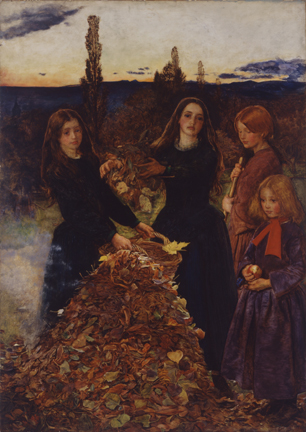
|
| John Everett Millais, Autumn Leaves, (1855-6). Manchester City Galleries. |
One year later Millais painted Autumn Leaves,
which was reported to be ‘a picture full of beauty and without a subject.’ The brush stroke no longer achieves
transparency but draws attention to itself. Painting rather than looking outside itself for confirmation looks inwards to
its own materiality and begins to create a strong boundary between itself and a hostile outside world. Notably painters begin
to look to Venetian art and the renaissance for inspiration. It is from this time that Rossetti returns to oil painting and
begins to concentrate on paintings of mysterious, moody, self-absorbed women such as Bocca BaciataI, 1859, and Lady
Lilith, 1868-73, who gazes with total fascination at her own image in the mirror, and is in Swinburne’s words ‘satiate
with its own beauty.’ Turned in upon themselves they symbolise an artificial and poetic world that has sacrificed the
need to communicate the truth of the external world. In its place Rossetti presents us with a plethora of sensuous riches
that belong to the painterly surface; Eve and Mary turned into Venus. This has the paradoxical result that even the most apolitical
of paintings becomes implicitly political. For his paintings offer the viewer a sensuous but essentially nostalgic experience
whose aesthetic values are implicitly in opposition to a utilitarian society.
The second phase of
Pre-Raphaelitism came about through the meeting of William Morris and Edward Burne-Jones in1853. Both were Oxford undergraduates
who like their PRB predecessors felt frustrated by their studies and uninspired by their teachers. Having graduated they gave
up their plans to enter the church and taking advantage of the manuscripts of the Bodleian library immersed themselves in
mediaeval stories and the reading of Ruskin. It was a year later that they learnt about the PRB and began to consciously model
themselves on them by dedicating their lives to art--Morris to architecture and design, Burne-Jones to painting. In 1861 Morris
established a decorative arts collective known as The Firm in which Burne-Jones and other artists who were members of the
second Brotherhood collaborated in the making of stained glass, textiles, tapestries and furniture for domestic and ecclesiastic
interiors. 1875 saw its total reorganisation with Morris as sole director and 1891 the establishment of the Kelmscott Press
that focused on the production of hand-printed books. Morris’s aims were twofold: to create an alternative to the tawdry
mass production of goods brought about by the industrial revolution and to restore to the craftsman his dignity of labour.
His mediaevalism was, as it had been for the first brotherhood, an implicit criticism of Victorian society and its deplorable
conditions of labour – the latter was always a source of great concern for Morris who, convinced that design alone could
not bring about a more egalitarian society, eventually devoted much of his time to the cause of socialism. The idealisation
of the mediaeval period characterises both stages of the Pre-Raphaelite movement but what differentiates the two brotherhoods
is that whereas the first Pre-Raphaelites attached great importance to scrupulous detail in their representation of the outside
world, with Morris and Burne-Jones the use of intricate patterning creates an inner world closer to that of myth or fairytales
that in some way counters the sense of biological instability that haunted the later Victorian mind. There is something claustrophobic
about the work of Burne-Jones and his concern for the beautiful seems to camouflage a profound anxiety, the Briar Rose
Series, 1870-84, evoking a death-like stasis in its slumbering protagonists caught up in the coils of the wild rose trees.
Painting for Burne-Jones was essentially the making of a beautiful decorative surface on which characters who are often taken
over with lassitude figure as elements in an elaborate pattern that promises a moment of aesthetic release.
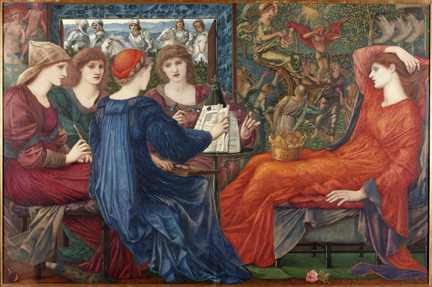
Edward Burne-Jones, Laus Veneris (1873-8). Laing Art Gallery, Newcastle upon Tyne.
Holman Hunt’s last painting The
Lady of Shalott,1886-1905, on the other hand could be taken to demonstrate
the re-emergence of the self. Unlike Waterhouse’s version his Lady of Shalott is curvaceous and robust.
Hunt was at this time penning his auto-biography that includes a revised
account of the history of the Pre-Raphaelites and declares himself the sole
true representative of the Brotherhood while accusing Rossetti, by this time assumed to be the leader of the group,
of defecting
to the Aesthetic camp; in Hunt’s words ‘leaving
stoicism for Epicureanism.’ For Hunt, the Lady of Shalott represents the
soul but also the artist whose mirror stands for ‘her own inspired mind’ Tempted
to quit the realm of art she looks out on to the external world, espies Sir
Lancelot and thereby shatters the mirror and forfeits her work and her artistic
life. Everything begins to unravel revealing the instability of reality and
representation. Hunt had just completed The Triumph of the Innocents before starting
on the Lady of Shalott. This extraordinary
painting is closer to the world of Burne-Jones in its melding of reality and
dream but unlike Burne-Jones demonstrates the impossibility of holding them
together.
Pre-Raphaelitism it must be admitted is a confusing movement, notably
because it contains within itself two diametrically different if not opposing
groups. This current exhibition, the latest in a long line of exhibitions
devoted to the Pre-Raphaelites (the most recent, in 2004, concentrated on
landscape and optics) argues that the movement represents a Victorian
avant-garde that predates the French Impressionists. This is by no means a new
argument. Seeming to corroborate this view is the acclaim that the English section
of the Paris Salon of 1855 was given for its daring formal invention and the
originality of its subject matter. Why then did we eventually lose out to the
French? I am thinking hard and find it difficult to come to a definite conclusion.
There is our Protestant ethic and the way Impressionism was successful in
depicting not only the modern appearance of things, people and places but the
actual experience of modernity and the sense of change on which it was based through
an innovative mode of handling the medium to create a certain surface interest.
Our attitude to the Pre-Raphaelites has in addition a lot to do with a
specifically English history of art history and the supremacy of a certain
version of modernism inherited from the Bloomsbury Group and subsequently taken
up by Clement Greenberg, whose views I respect to a certain degree. This
account, which accepted abstraction as modernism’s teleological goal, is now often
declared outmoded. We are told we live in a post modernist world where
narrative and realism are no longer ostracised. And yet I have some difficulties
in accepting Pre-Raphaelitism as modern. That they were avant-garde is easier
to accept; the Arts and Crafts movement gave rise to numerous artistic progeny,
notably the Bauhaus; the Aesthetic Movement was based on a formalist aesthetic
that eventually gave rise to abstraction, while Symbolism is the antecedent of
Surrealism. So, yes to the question the curators have set us,a but still with
quite a number of reservations.
© Anna Leung November 2012
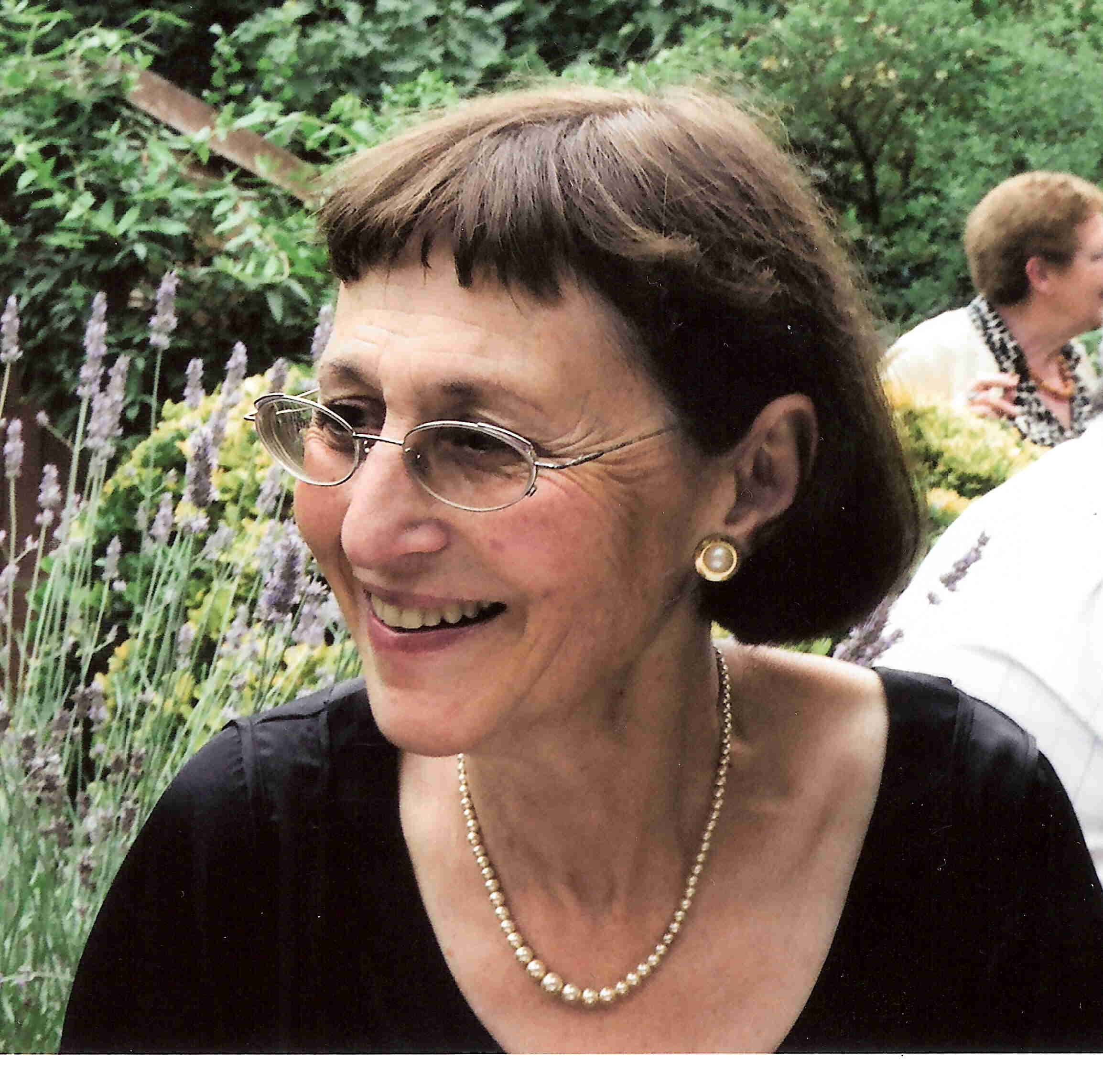
Anna Leung
is a London-based
artist and educator
now semi-retired from
teaching at Birkbeck
College but
taking occasional
informal
groups to current
art exhibitions. Pre-Raphaelites: Victorian Avant-Garde was at the Tate Britain, London, from 12 September 2012 - 13 January 2013. .
|
